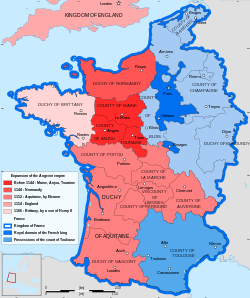County of Champagne
Appearance
You can help expand this article with text translated from the corresponding article in French. (November 2022) Click [show] for important translation instructions.
|
County of Champagne
| |||||||||||
|---|---|---|---|---|---|---|---|---|---|---|---|
| 690–1314 | |||||||||||
 France in 1154 | |||||||||||
| Status | Vassal state of Kingdom of France | ||||||||||
| Religion | Roman Catholicism | ||||||||||
| Government | Feudal County | ||||||||||
| Count of Champagne | |||||||||||
• 690-707 | Drogo | ||||||||||
• 1305-1314 | Louis X | ||||||||||
| Historical era | Middle Ages | ||||||||||
• Established | 690 | ||||||||||
• County merged with the French Crown | 1314 | ||||||||||
| |||||||||||
| Today part of | France | ||||||||||
The County of Champagne (Latin: Comitatus Campaniensis; Old French: Conté de Champaigne),[1] or County of Champagne and Brie, was a historic territory and feudal principality in France descended from the early medieval kingdom of Austrasia. The county became part of the crown lands due to the marriage of Queen Joan I of Navarre, who was the countess of Champagne, and King Philip IV of France.[2]
History
[edit]The county reached its peak as one of the richest and strongest of the French principalities during the rule of Henry I. The court of Champagne became a renowned literary center,[3] and the county hosted the Champagne fairs at their height. The countship passed to the French crown in 1314, forming the province of Champagne.[4]
See also
[edit]References
[edit]- ^ Dictionnaire topographique de la France. 1871. p. 55.
- ^ Cazelles, Raymond (1958). La société politique et la crise de la royauté sous Philippe de Valois (in French). Paris: Librairie d'Argences.
- ^ Benton, John F (1961). "The Court of Champagne as a Literary Center". Speculum. 36 (4): 551–591. doi:10.2307/2856785. JSTOR 2856785. S2CID 161184362.
- ^ Longnon, Auguste (1911). . In Chisholm, Hugh (ed.). Encyclopædia Britannica. Vol. 5 (11th ed.). Cambridge University Press. pp. 827–828, see page 828, first para, last sentence.
Louis Hutin, became count of Champagne. He was the last independent count of the province, which became attached to the French crown on his accession to the throne of France in 1314
External links
[edit]
